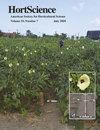佛罗里达州黄龙冰特有条件下“帕森布朗”和“哈姆林”甜橙的比较研究
IF 1.6
3区 农林科学
Q2 HORTICULTURE
引用次数: 0
摘要
韧皮部限制性细菌Candidatus Liberibacter asiaticus(CaLas)引起的柑橘绿化或黄龙病(HLB)威胁着全球柑橘产业。实地观察表明,一些柑橘品种比其他品种更能耐受CaLas病原体“Parson Brown”是一种早熟甜橙品种,在类似条件下,与“Hamlin”甜橙相比,其在田间的叶片和果实下降幅度一直很小。本研究旨在了解“帕森斯-布朗”品种在佛罗里达州柑橘生产区的几个地点的表现。结果表明,两个品种的CaLas细菌滴度相似,“哈姆林”的定量聚合酶链式反应循环阈值在24.99至28.61之间,“帕森斯-布朗”的定量pcr循环阈值在25.48至30.89之间。然而,“帕森斯-布朗”树的叶子在大多数地方表现出较高的叶绿素含量和总酚类化合物。我们还检测到,在第一个采样期(3月)和第四个取样期(11月),‘Parson Brown’叶片中CsPR1和CsPR2转录物的相对表达较高。此外,与“哈姆林”相比,“帕森斯-布朗”叶片中Phloem蛋白2转录物在所有位置都下调。“哈姆林”果汁的酸度较高,而“帕森斯-布朗”果汁的白利糖酸比和果汁颜色较高。果汁中的含油量在0.020%到0.042%之间,并且不同位置之间的含油量存在差异,这可能表明克隆差异。”然而,在大多数地区,帕森斯-布朗果汁的柠檬苦素和诺米林含量都高于哈姆林果汁。总之,目前的结果证实,与所有采样位置的“哈姆林”相比,“帕森斯-布朗”树对HLB的耐受性增强。本文章由计算机程序翻译,如有差异,请以英文原文为准。
A Comparative Study between ‘Parson Brown’ and ‘Hamlin’ Sweet Oranges Growing under Endemic Huanglongbing Conditions in Florida
Citrus greening, or huanglongbing (HLB), caused by the phloem-limited bacterium Candidatus Liberibacter asiaticus (CaLas), threatens the global citrus industry. Field observations have demonstrated that some citrus cultivars are more tolerant to the CaLas pathogen than others. ‘Parson Brown’ is an early maturing sweet orange variety that has consistently exhibited minimal leaf and fruit drop in the field compared with the ‘Hamlin’ sweet orange under similar conditions. This study aimed to understand performance of the ‘Parson Brown’ cultivar in several locations across the citrus production regions of Florida. Results indicated that the CaLas bacterial titer in both cultivars were similar with the quantitative polymerase chain reaction cycle threshold values ranging between 24.99 and 28.61 in ‘Hamlin’ and between 25.48 and 30.89 in ‘Parson Brown’. Leaves from the ‘Parson Brown’ trees however demonstrated higher chlorophyll content and total phenolic compounds in most of the locations. We also detected higher relative expression of CsPR1 and CsPR2 transcripts in ‘Parson Brown’ leaves in the first sampling period (March) and the fourth period (November). Additionally, Phloem protein 2 transcripts were downregulated in ‘Parson Brown’ leaves compared with ‘Hamlin’ at all locations. The ‘Hamlin’ juice had higher acidity, whereas ‘Parson Brown’ juice demonstrated a higher Brix to acidity ratio and juice color. The oil content in the juice ranged between 0.020% and 0.042%, and there was variation in the oil content between the locations, which could indicate clonal differences. ‘Parson Brown’ juice however contained higher limonin and nomilin content than ‘Hamlin’ juice in most of the locations. Taken together, the current results confirmed the enhanced tolerance of ‘Parson Brown’ trees to HLB when compared with ‘Hamlin’ in all sampled locations.
求助全文
通过发布文献求助,成功后即可免费获取论文全文。
去求助
来源期刊

Hortscience
农林科学-园艺
CiteScore
3.00
自引率
10.50%
发文量
224
审稿时长
3 months
期刊介绍:
HortScience publishes horticultural information of interest to a broad array of horticulturists. Its goals are to apprise horticultural scientists and others interested in horticulture of scientific and industry developments and of significant research, education, or extension findings or methods.
 求助内容:
求助内容: 应助结果提醒方式:
应助结果提醒方式:


